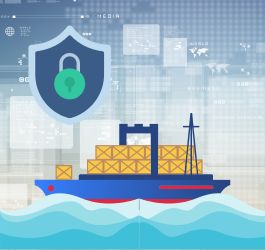In today's fast-paced and interconnected world, technology has become an indispensable driver of business growth and success.
From small startups to multinational corporations, organizations across industries have harnessed the power of technology to innovate, streamline processes, and unlock new opportunities.
In this digital age, technology has proven to be a catalyst for growth, empowering businesses to reach new heights and navigate complex challenges with agility.
According to the Digital 2023 Global Overview report, the average daily time spent using the internet in 2022 was 6 hours and 37 minutes. When we consider the time spent using computers for work, our total daily usage of electronic devices exceeds one-third of our day, even surpassing the time we spend on sleep

However, our extended time spent online has exposed us to cyber vulnerabilities and risks.
Our increasing reliance on technology and the internet in our daily lives brings forth the essential need for cyber security.
In this blogpost we will explore how digitalization has bright forth technological advancements to the current age. What is cyber security and the vulnerabilities without it. And ending off with ways you can protect yourself from these cyber threats.
Digitalization In This Global Age
The pervasive influence of digital technologies has transformed the way we live, work, and interact with one another. From communication and commerce to education and entertainment, digitalization has revolutionized nearly every aspect of our lives.
For example, by the widespread adoption of intelligence in the manufacturing industry since the emergence of Industry 4.0, and it has led to the integration of IT (Information Technology) and OT (Operational Technology) systems.

This integration aims to leverage the existing manufacturing resources, sales processes, and big data to establish an agile manufacturing industry that can swiftly adapt to market demands, ensure precise production, minimize cost wastage, and foster cross-domain collaboration.
Such systems have been defined, devised, and developed to help make our day-to-day life more efficient.
IT systems are like our brain, responsible for processing and managing information, controlling various functions, and coordinating interactions between different systems.
IT systems encompass computers, networks, software, and they handle the processing, storage, transmission, and analysis of information.
On the other hand, OT systems are like our body, responsible for monitoring, controlling, and executing practical operational tasks such as production lines and industrial manufacturing.
OT systems typically include sensors, actuators, controllers, and monitoring systems.
Despite the benefits, we cannot deny the risks digitalization has brought us.

According to the 2022 Internet Crime Report produced by the FBI’s Internet Crime Complaint Centre (IC3), dollar losses to cybercrimes increased significantly by 49%.
In Singapore, according to the Annual Scams and Cybercrime Brief 2022 by the Singapore Police Force, cybercrime cases increased by 25.2%, and the total amount that has been scammed increased by 4.5% to $660.7 million in 2022, from $632.0 million in 2021.
We have seen firsthand on news or thought word of mouth on how rates of cybercrime increase annually due to the growing reliance on digital technologies and interconnected systems across various industries.
As more businesses and individuals conduct their operations online, cybercriminals find new opportunities to exploit vulnerabilities and launch sophisticated attacks.
There is ONLY one way to stop cyber attacks...
And it is to enhance our cyber security landscape!
What Is Cyber Security?

Cyber security refers to the use of technology, personnel, and processes to safeguard the computers, data, applications, and devices of companies or individuals from digital attacks.
With the advancement of technology and changes in societal structures, the methods of cyber-attacks have become increasingly numerous and complex.
It is essential to have a heightened awareness of the potential risks and employ effective internet security solutions to protect critical assets.
From individuals to businesses and even governments, the consequences of inadequate cyber security are far-reaching and severe.
Common Cyber Attacks

The most common yet concerning result of the lack of cyber security will be cyber attacks on vulnerable systems.
During a cyber attack, one opens themselves to potentially losing private and sensitive information that could harm personal and professional interests. From financial institutions and businesses to government agencies and individuals, everyone is equally in danger to such threats.
To effectively respond to online attacks, it is crucial to accurately identify the specific type of attack we are encountering. Here are some common types of attacks that demand our attention:
Malware
Malware is the most common type of cyber-attack.
Cybercriminals distribute malicious software (which can be programs or code), such as Trojans, viruses, and worms, through infected emails, pop-up ads, or compromised websites.
Once infiltrated, malware can steal sensitive data, cause system damage, or facilitate unauthorized access.
Phishing
Attackers often impersonate companies that contain personal confidential information, such as banks or telecommunications companies, and send emails, text messages, or instant messages to victims.
These messages will include fake links, and when victims click on the links and enter personal information due to their trust in these companies, the data falls into the hands of the fraudsters.
DoS and DDoS
A Denial-of-Service (DoS) attack comes from a single source and is performed by sending a large volume of traffic to overwhelm the target device, causing it to crash.
Its objective is to render the system inaccessible, leading to inconvenience and potential financial losses for the affected organization or individuals relying on its services.
On the other hand, Distributed Denial-of-Service (DDoS) attacks involve multiple sources collaborating to overwhelm the target.
MitM
Man-in-the-middle (MitM) attack occurs when a third party (hacker) intercepts a conversation between target A and target B.
When target A sends a message, it passes through the hacker first, enabling the hacker to read or modify the message before forwarding it to target B
SQL Injection
It refers to a security vulnerability that occurs at the database layer of an application. This vulnerability involves the insertion of SQL commands within input strings.
If a poorly designed program fails to adequately validate these inputs, the embedded commands can be misinterpreted as valid SQL commands by the database server and executed, leading to exploitation by malicious code.
Social Engineering
Social engineering attacks rely on manipulating individuals rather than exploiting technical vulnerabilities.
Attackers leverage psychological tactics, such as impersonation, deception, or coercion, to trick people into revealing sensitive information, granting unauthorized access, or performing actions that benefit the attacker.
These attacks exploit human vulnerabilities, making individuals' unawareness to involve them in compromising the security of systems or revealing confidential information without their knowledge.
Zero-day Exploits
Zero-day exploits target unknown vulnerabilities in software before they are discovered and patched by developers.
Attackers exploit these vulnerabilities to gain unauthorized access, execute malicious code, or perform other malicious activities.
How To Protect Against Cyber Vulnerabilities

Knowing the dangers that lurk during the lapse in secure cyber security, protecting against cyber attacks has become a critical priority for individuals and organizations alike.
With the ever-evolving tactics employed by cybercriminals, it is imperative to adopt proactive measures to safeguard sensitive information, preserve privacy, and ensure the integrity of digital assets.
There are different types of cybersecurity that come together to create a comprehensive system that protects the entire enterprise's computer network.
It can be divided into the following major categories :
Network Security
Network security is designed to protect the network from unauthorized user access and to prevent them from gaining essential information or assets.
There are numerous prevention procedures and programs that fall within the scope of network security :
- Firewall
- Intrusion Detection Systems (IDS)
- Intrusion Prevention Systems (IPS)
- Virtual Private Networks (VPNs)
- Network access control (NAC )
- Data Encryption
- Authentication Control
- Patch Management
- Security Policies and Procedures
- Employee Education and Awareness
Application Security
Application security refers to the practice of protecting software and devices from threats, making it a crucial aspect of the software development lifecycle. It should begin before any software development and conduct regular security assessments, penetration testing, and code reviews to identify potential weaknesses. Overall, prioritizing application security is crucial to maintaining user trust and protecting valuable assets.
Cloud Security
Cloud security, also referred to as cloud computing security, aims to establish a secure environment for organizations to store and manage their data and information. It can be categorized into two aspects:
- Platform responsibility
- Users' responsibility
Cloud service providers (CSPs) are responsible for securing their data centers, implementing firewalls, and managing user access to cloud resources. They have the duty to establish a secure environment for organizations to store and manage their data.
Users need to adopt safe usage practices and adhere to security guidelines.
Information Security
Information security is vital for protecting sensitive information from unauthorized access. It uses access controls, encryption, and incident monitoring to manage risks proactively.
The fundamental principle is the CIA Triad, which focuses on:
- Confidentiality
- Integrity
- Availability

This means keeping data confidential, maintaining its integrity, and ensuring it is available when needed. By upholding these principles, information security safeguards data privacy and reliability in storage and transmission.
Operational Security
Operational security, or OPSEC, is a set of practices to protect sensitive information and critical assets in organizations.
Its main goal is to prevent adversaries from gaining valuable information that could be used against them.
It involves identifying and mitigating vulnerabilities to minimize the risk of breaches.
Disaster Recovery
Disaster recovery is the process and strategies of an organization to restore and recover critical systems, operations, and data following a disruptive event or disaster.
Disasters can include cyber-attacks, hardware failures, or power outages.
The goal of disaster recovery is to minimize downtime, restore business continuity, and mitigate the negative impact on an organization's operations, infrastructure, and data.
It involves implementing a set of procedures, policies, and technologies that enable the rapid recovery of IT systems, applications, and data to a pre-defined acceptable level.
Data Security
Data security pertains to safeguarding digital information from unauthorized access, use, disclosure, disruption, or alteration.
It involves the implementation of various measures and adoption of practices to ensure the confidentiality, integrity, and availability of data.
Essential tools for data security include encryption, sensitive file redaction, and data masking capabilities. Data security is crucial for organizations to safeguard sensitive information and prevent unauthorized misuse.
Education
According to the 2022 Phishing by Industry Benchmarking report , 32.4% of untrained employees are likely to be tricked into interacting with a malicious link. This means 1 out of 3 employees are likely to cause a cyber breach without any prior training.
In the same report, it is also reported that 82% of cyber security breaches are a result of human error.
The numbers have proven that cyber criminals have identified the overall lack of cyber security knowledge in individuals as a weak point to any organization’s cyber security landscape.
No matter how much time and money are spent on upgrading the best protection system, if the employees are not well educated, there will forever be a vulnerable gap that will always be taken advantage of.
Proper training for employees can come in many forms, in person training courses, to online video courses. Employees who attend proper training are more confident with their skill sets and can perform better.

Athena Dynamics Academy is an online education platform that focuses on the educational aspect of cybersecurity. Athena Dynamics firmly believe that educated personnel, combined with effective cyber technology, are essential for maintaining online security.
Conclusion
The importance of cybersecurity is self-evident. For any organization, protecting essential assets is the responsibility of every employee.
The most effective approach is to provide them with our training courses. As one of the wisdom quoted that:
Give a man a fish, and you feed him for a day. Teach a man to fish, and you feed him for a lifetime.
Just like a loose screw can potentially cause the breakdown of an entire machine, it is crucial to properly train your employees to understand how to identify, prevent, and resolve cyber threats.










